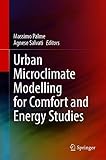Urban Microclimate Modelling for Comfort and Energy Studies [electronic resource] / edited by Massimo Palme, Agnese Salvati.
Contributor(s): Palme, Massimo [editor.] | Salvati, Agnese [editor.]
| Salvati, Agnese [editor.] | SpringerLink (Online service)
| SpringerLink (Online service) .
.
Material type:  BookPublisher: Cham : Springer International Publishing : Imprint: Springer, 2021Edition: 1st ed. 2021.Description: XXIV, 556 p. 225 illus., 194 illus. in color. online resource.Content type: text Media type: computer Carrier type: online resourceISBN: 9783030654214.Subject(s): Sustainable architecture
BookPublisher: Cham : Springer International Publishing : Imprint: Springer, 2021Edition: 1st ed. 2021.Description: XXIV, 556 p. 225 illus., 194 illus. in color. online resource.Content type: text Media type: computer Carrier type: online resourceISBN: 9783030654214.Subject(s): Sustainable architectureChapter 1. Introduction: Anthropocene or Urbanocene? -- Part 1. Urban climate and sustainability: energy performance and thermal comfort in cities -- Chapter 2. The city as a complex thermodynamic system -- Chapter 3. The energetic basis of the urban heat island -- Chapter 4. Outdoor thermal comfort -- Chapter 5. Energy implications of urban microclimate in high latitudes -- Chapter 6. Climate and Energy performance of Mediterranean compact cities -- Chapter 7. Enhancing energy performance and comfort of built environment in tropical climates -- Chapter 8. Urban thermal comfort in arid climates -- Chapter 9. Integrating urban climate knowledge: The need for a new knowledge infrastructure to support climate responsive urbanism -- Part 2. Urban climate modelling and simulation: physics and tools -- Chapter 10. Air circulation in urban areas -- Chapter 11. The coupling of the weather research and forecasting model with the urban canopy models for climate simulations -- Chapter 12. The Urban Weather Generator model: Physics-based microclimate simulation for performance-oriented urban planning -- Chapter 13. The Solene-microclimate model: potentiality for comfort and energy studies -- Chapter 14. Comparing ENVI-met and Grasshopper modelling strategies to assess local climates and urban heat island effect -- Chapter 15. Urban microclimate and building energy simulation coupling techniques -- Chapter 16. RayMan and SkyHelios model -- Chapter 17. A methodology for assessing the impact of climate change on building energy consumption -- Part 3. Applying urban climate modelling in policy, planning and design: case studies -- Chapter 18. Spatial metrics to investigate the impact of urban form on microclimate and building energy performance: an essential overview -- Chapter 19. Green infrastructures to mitigate extreme temperatures in cities -- Chapter 20. Urban morphology as a mitigation strategy of urban warming in oasis cities of arid regions -- Chapter 21. Human biometeorogical models – existing and future reflections for Lisbon -- Chapter 22. Impact of local urban climate on building energy performance: case studies in Mendoza, Argentina -- Chapter 23. Green infrastructure to reduce the energy demand of cities -- Chapter 24. Cool materials for passive cooling in buildings.
This book discusses urban microclimate and heat-related risks in urban areas, brought on by the combination of global climate change effects and local modification of climate determined by extensive urbanization such as the ‘Urban heat island’ phenomenon. This matter is relevant to almost all urbanized areas in the world, where the increase of urban population and air temperature is expected to endanger both the overall health of the population and the energy supply for the functioning of urban systems. The book details the inter-relationship between urban morphology, microclimate and building energy performance and presents a multidisciplinary approach that brings together Urban Climatology, Engineering and Architectural knowledge to support the development of reliable models and tools for research and practice. This book is a useful tool for architects and building energy modelers, urban planners and geographers who need a practical guide to realize basic urban microclimate simulation for use in both academic research and planning practice. A multidisciplinary overview of the research field and its importance to different disciplines working on urban scale issues; Advances knowledge on tools and models for urban climate analysis; Provides a model for effectively integrating urban climate knowledge into the planning and designing processes.


There are no comments for this item.